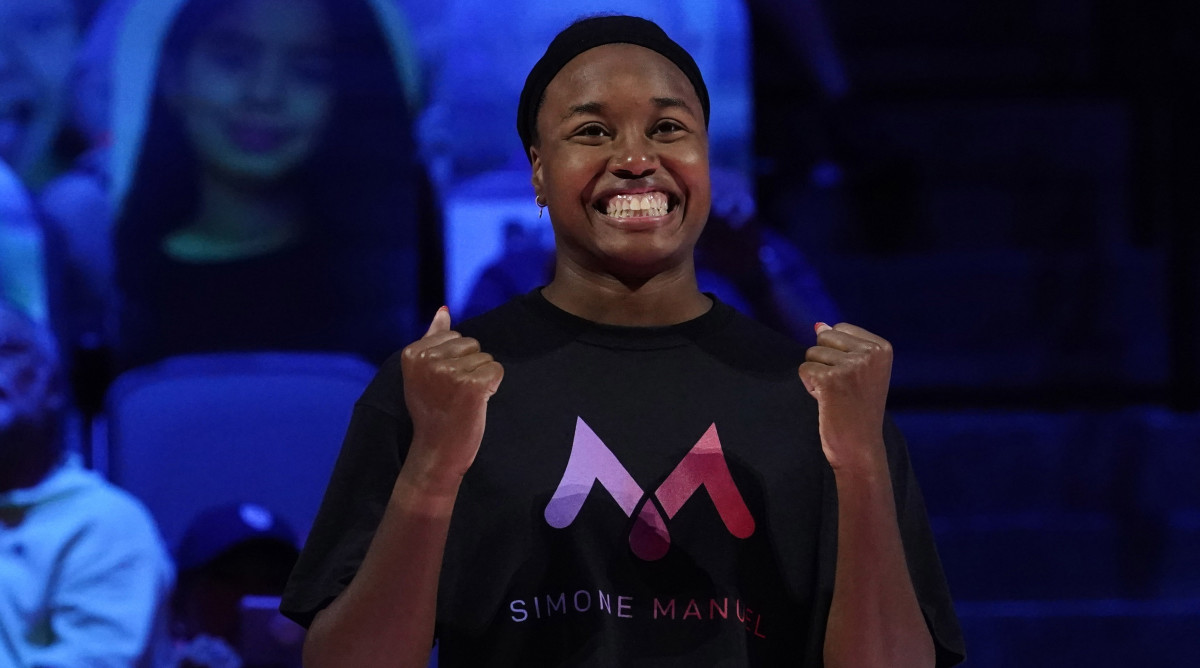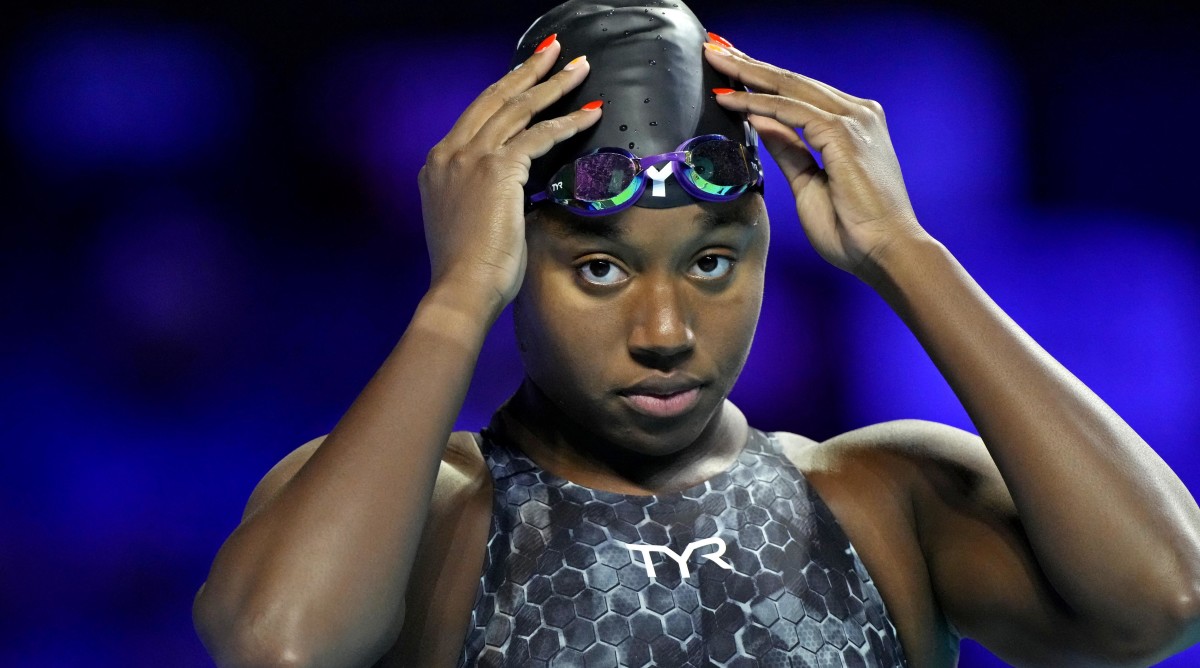Simone Manuel Had to Conquer More Than Her Competitors to Make the Tokyo Olympics
Sign up for our free daily Olympics newsletter: Very Olympic Today. You'll catch up on the top stories, smaller events, things you may have missed while you were sleeping and links to the best writing from SI’s reporters on the ground in Tokyo.
In May, with the struggle ongoing and the clock ticking toward an immovable performance deadline, Sharron Manuel assessed the weight upon her daughter and offered an out: You don’t have to do this, Simone. You don’t have to go to the U.S. Olympic Swimming Trials.
For months, America’s best sprinter had quietly been laid out by overtraining, a medical diagnosis she had never heard of. It left her with an accelerated heart rate, general fatigue, muscle aches and depression. To the knowledge of very few, she missed three weeks of training in March—which in a workload-intensive sport is a disaster. Tokyo dreams were teetering.
Come mid-June, the U.S. Olympic swim team would be selected from a pressure-packed trials meet that offers no do-overs and no exemptions—you make the team there, in competition against the rest of the best in the nation, or you do not. Against that dire backdrop, Sharron wanted Simone to know that it would be O.K. if she told the world what she was enduring and opted out.
That was quickly rejected. “I would rather fail because I did everything I could to be successful but fell short,” Simone says, “than to fail because I didn’t try at all.”
She tried, and she did fail. Manuel did not land a spot on the team in her best event, the 100-meter freestyle. To the shock of those who weren't in the know, the American record-holder in the event and reigning Olympic gold medalist didn’t even make the eight-woman final.
But then she tried again, a few days later, in the 50-meter free. Summoning a wherewithal that had been battered throughout 2021, Manuel advanced through the preliminaries and semifinals. And with her Olympic hopes riding on it, she delivered in the final, getting her hand on the wall first by a single one-hundredth over runner-up and fellow qualifier Abbey Weitzeil.
As her Stanford teammates enveloped her in a poolside embrace in Omaha, Manuel’s dominant emotion was relief. For everyone else, it was awe. Her coach, Greg Meehan, described that clutch performance as “so representative of Simone's competitive spirit. … Her mental toughness and her competitive spirit [are] what makes her truly great. That was amazing to see. She just willed herself to that.”

Today, less than two months removed from her mom's asking whether she even wanted to go through with competing at trials, Simone Manuel is a freshly named co-captain of the U.S. Olympic swim squad by a vote of her teammates. She’s qualified individually in only the 50, but she still might represent a secret relay weapon of sorts for the Americans.
Meehan, who also is the American women’s team coach for Tokyo, said Thursday that Manuel is “keeping her focus on her individual event,” but acknowledged that the goal is “putting together the four best athletes possible” for all relays. If Manuel regains enough of her old form, that could put her in the mix. She won five relay medals at the FINA World Championships in 2019 and has been part of multiple world-record relays.
But even if Manuel swims just one event in Japan, she has delivered something that seemed unlikely not long ago. All it took to advance this far is everything she had, including a few things she might not have known she had.
“I learned that she is stronger than I thought she was,” Sharron Manuel says.
“If you have a dream, nothing can stand in your way—including yourself,” Simone said last week from Team USA training camp in Hawaii. “I’ve dealt with the doubts of others, but also with my own doubts.”
The doubts began building early in 2021, when recovery from hard practices was more difficult than usual. Simone told her mother at one point that she had a bad week of practice, which caught Sharron by surprise—a bad day, maybe, but she had never heard her hardworking daughter say an entire week was off. By the time Manuel and her Stanford teammates got to the first major national meet in a year, in San Antonio in early March, the struggle was about to fully manifest itself.
Manuel won both the 50- and 100-meter freestyle at that meet, but her times were a giveaway that she was far off form. Instead of returning to California, she went home to Houston to consult with doctors. She was referred to Dr. Rehal A. Bhojani, an orthopedic expert with UT Physicians and The University of Texas Health Science Center at Houston, who works with several athletic programs in the state.
After an array of tests, Bhojani told Manuel she was overtraining, which he described as the far end of an exercise-related continuum ranging from fatigue to overreaching to overtraining. Bhojani described it in layman’s terms: “Your body has taken a load on that it may not be able to handle.”
Bhojani stressed that early identification of overtraining is key. “Not treatment, but prevention,” he says. “We should figure out how to identify it earlier.” In Manuel’s case, she had done what elite athletes tend to do—trying to simply power through instead of backing off.
It was Bhojani who prescribed three weeks of rest. Given the timing, that recommendation was not what Manuel wanted to hear—but he warned her that continuing to train without ceasing could be career-threatening. “It was really a difficult conversation,” he said. “But I think once she got into the rest period, she started to turn the corner.”
Sharron Manuel says her daughter “slept and slept and slept” during that time. “Pretty much the only things she did was sleep, get massages and try to eat well.” A massage therapist told her, “Your body is a mess.”

During that time off, Manuel missed a meet in Mission Viejo, Calif. That raised some eyebrows in the sport, since there had been so few meets in the previous year and competition was at a premium. Meehan simply said that Manuel was dealing with some health issues but was expected to be back on schedule soon.
But her practice regimen remained limited, and it was on a visit to Palo Alto that Sharron Manuel raised the possibility of her daughter's skipping Olympic trials altogether. While Simone refused to go that route, she still was on an unsure path of preparation in the final weeks before trials.
“Everyone is on high alert,” Sharron says. “How are you feeling today? How do your muscles feel? Are you getting rest? Now maybe you’re overthinking it.
“That’s the roller coaster ride she was on: How hard can you push? How much can you handle? She was getting up every day trying to be positive about trials, while you’re thinking things are slipping through your fingers. It was like being in a pressure cooker, every minute of every day.”
There was an added dynamic at play here: Manuel’s status within her sport. She is the rare Black superstar swimmer, which has made her a welcome role model but also applied some added responsibility. The idea of letting down a whole cross section of fans and followers weighed heavily.
“Simone, if we’re being honest, has some different burdens to carry than others in this sport,” Sharron says. “It can be exhausting. You didn’t campaign for this. It’s been placed on you, and you’re trying to do the best you can.”
The final trials tune-up was a meet in Austin in May. Manuel performed well there, swimming her best 100 freestyle times of 2021, which offered some renewed hope. At a press conference in Omaha just before Olympic trials, she betrayed no hint of what had transpired over previous months—there would be no prerace excuse-making.
Once she started competing, it didn’t take long to realize Manuel wasn’t right. She swam two 100s in the 54-second range, the second of which left her 17th and out of the running to make the Olympic team in that event. That’s when Manuel decided to meet the media and, through occasional tears, lay all her cards on the table.
“It’s definitely hard for me to be sitting up here,” Manuel said, though she articulated her struggle for 24 minutes at the podium. Among the things she said was that she was not dropping out of the meet and would compete in the 50 on the final two days of competition.
Getting the overtraining conversation out of her head seemed to help. She got through the preliminaries and semifinals easily, qualifying third for the final—but only the top two would advance to Tokyo. Manuel put together 24.29 gritty, clutch seconds of racing to punch her ticket. The time was only the ninth-fastest of her career in that event, but it was good enough to make her a two-time Olympian.
An Olympic berth and captain status aren't the end of the saga, however. Bhojani warns that Manuel “has a long way to go” in terms of getting herself back to full health. The timeline is open-ended, he says, but there will be more rest prescribed after the Olympics. “I think that will be important for her,” he says. “There’s a reason why there are offseasons.”
More Tokyo Olympics Coverage:
• The GOAT's Greatness Is Still to Come
• How Jumper Quanesha Burks Made Her Way to Team USA
• There Is Still Chlorine in Michael Phelps’s Soul
